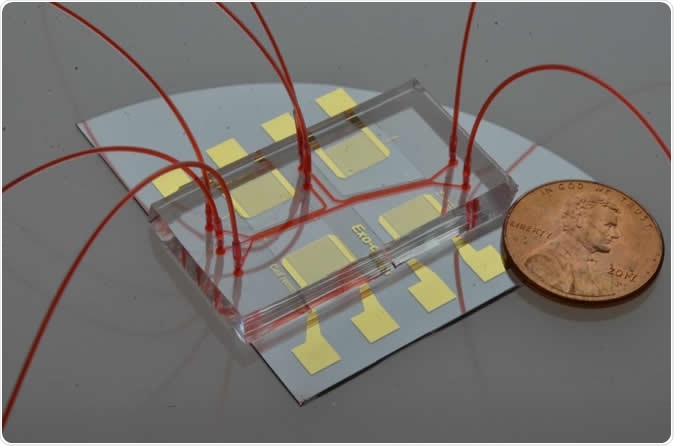Cancer of the throat and mouth (oropharyngeal cancers, OPC) are common, and are increasing in incidence especially among younger people. However, these are difficult to diagnose as they are not seen either by the patient or during routine medical examinations.
A new paper published in the Journal of Molecular Diagnostics report that a new method called acoustofluidics can be used to look for the presence of a virus that is strongly linked with these cancers, in the saliva. It detected OPC in 40% of the patients who underwent testing and picked up 80% of confirmed OPCs, using whole saliva.

Acoustofluidic exosome isolation chip for salivary exosome isolation. The microfluidic channel is shown by red dye solution and the coin demonstrates the size of the chip. Two pairs of gold interdigital transducers are deposited along the channel, which separates particles according to size. Image Credit: The Journal of Molecular Diagnostics
Preventing OPC
Almost 120 000 OPCs are found each year, and the number in developed countries is rising each year because of the sexually transmitted virus, human papilloma virus strain 16 (HPV 16). This paper describes, therefore, a big step forward in controlling the disease in the early stages, in addition to preventing high-risk sexual behavior which spreads the virus in the first place.
Prevention is better than cure, as all the world knows. Primary prevention would therefore definitely include passing on the message of responsible sexual behavior, which includes abstinence until the time one is ready to enter this phase of life without incurring health risks, regrets or fears.
Researcher Tony Jun Huang says, “OPC is one of the fastest-rising cancers in Western countries due to increasing HPV-related incidence, especially in younger patients. It is paramount that surveillance methods are developed to improve early detection and outcomes.”
From the point of view of secondary prevention, the researchers say that being able to detect HPV from exosomes (cavities within the cell bounded by membranes that contain signaling molecules for cellular processes, including RNA) in saliva using the acoustofluidic platform can allow the early detection, risk assessment and screening of patients at risk for OPC.
About exosomes
Exosomes are very small vesicles, membrane-bound intracellular spaces, with diameters on a microscopic scale, that are formed inside the cells and are released into the body fluids by the cells. They help cells communicate with each other by carrying signaling proteins, microRNA, and other biomolecules to other sites. They have been found to be increased in many kinds of cancer.
The current study
The technology being used in the current research is a combination of microfluidics and acoustics, whereby a small acoustofluidic chip is used to separate exosomes in saliva, via the removal of unnecessary particles by a size gradient-based isolation method. The sample that is left behind will be rich in exosomes, and this will make it simpler to pick out the changes in biomolecules that signal the presence of a tumor.
The researchers took saliva samples from 10 patients who had HPV-linked OPC diagnosed using conventional methods. They subjected these samples to acoustofluidic testing and found that if they coupled it with droplet digit PCR, they could find HPV-16 DNA in 80% of them.
Advantages of acoustofluidic detection
The advantage of this method is that it doesn’t change in efficiency of detection even if the saliva is more or less viscous and doesn’t depend on the method used. Moreover, it is an automated and rapid process, yielding isolated exosomes within 5 minutes whereas currently used benchmark processes require over 8 hours. The cost is much lower than for comparable technologies in use today, and it can be used at the point of care. Moreover, repeated examination is possible in a non-invasive manner, and this allows continuous long-term monitoring of the patient, to assess the progression of the tumor as well as changes following treatment. Thus, it could be put into practice clinically with great ease.
Huang elucidates on the saliva exosome liquid biopsy technique: “With these features, the acoustofluidic technology has the potential to significantly exceed current industry standards, address unmet needs in the field, help expedite exosome-related biomedical research, and aid in the discovery of new exosomal biomarkers.”
Other investigators chime in, saying it is effective in early detection of and risk assessment for OPC. Not only so, it is rapid, does not harm the biological sample, does not use labels, uses pure samples, and produces a highly impressive yield of salivary exosomes. It could be applied to test blood, plasma, or urine as well, they say.
Conclusion
If validated, it could help enormously to detect these treatable and fast-increasing cancers. In addition, the researchers envisage the application of this technique to help doctors predict which patients will be best treated by radiation therapy, and to bring about a longer period of survival without progression. If so, this interdisciplinary study carried out across continents will have marked real progress towards cancer control.
Journal reference:
Acoustofluidic Salivary Exosome Isolation Wang, Zeyu et al. The Journal of Molecular Diagnostics, https://jmd.amjpathol.org/article/S1525-1578(19)30395-2/fulltext